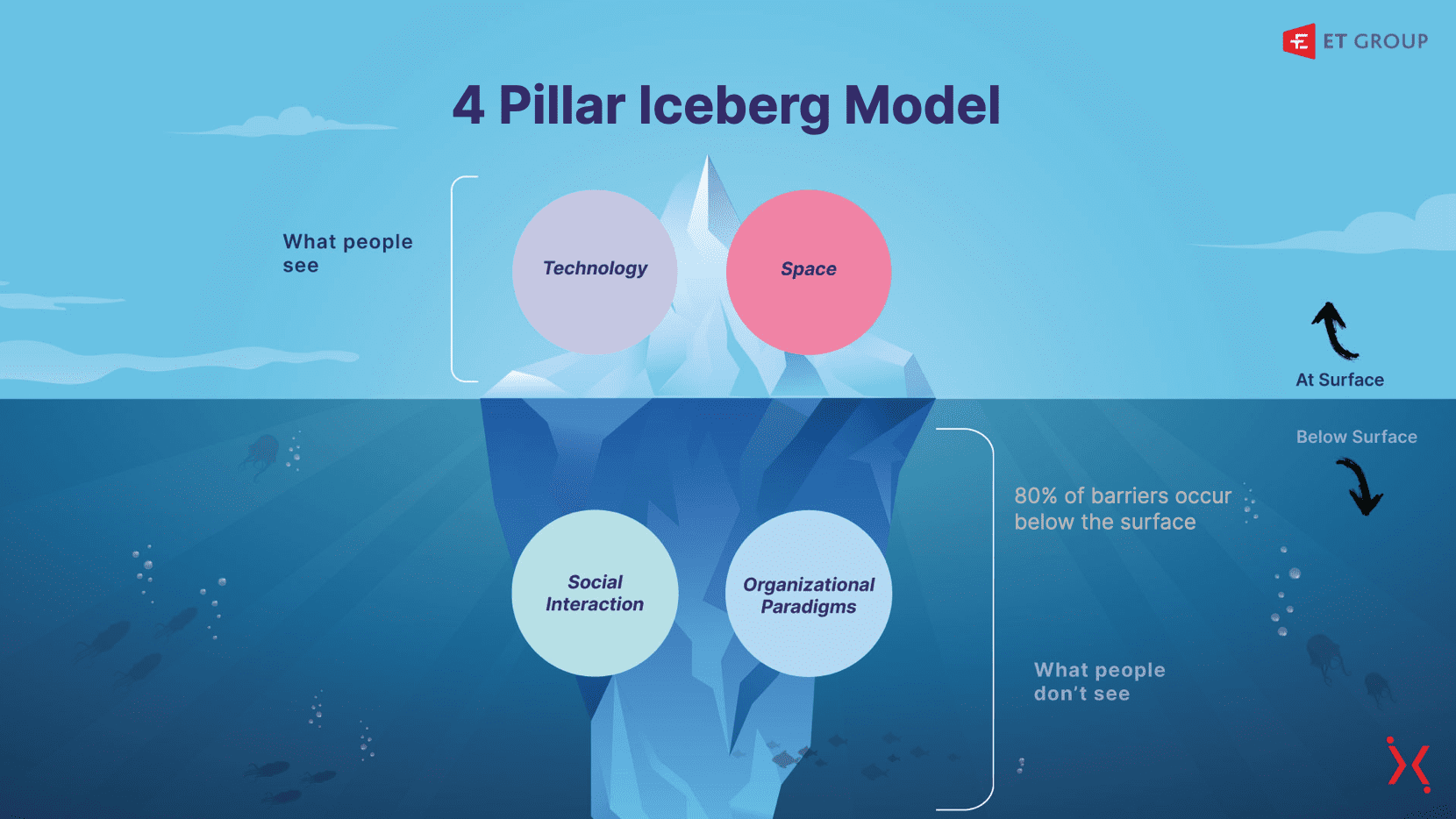To find out why companies are struggling with hybrid collaboration, ET Group teamed up with WORKTECH Academy to run a workshop on common challenges. The results shine a light on social and cultural challenges
Reposted article from WORKTECH Academy
It’s one of the most conspicuous and most talked-about challenges in the emerging world of flexible work – how to give everyone hybrid meeting equality so all employees enjoy a high-quality collaborative experience irrespective of whether they have joined remotely or are attending in-person at the office.
Companies are aware of the issue and willing to experiment to find solutions, but they’re finding that they face an uphill struggle. Despite their best efforts, neither investment in new technology nor redesign of meeting space – the two reflex responses to the challenge – are really moving the dial.
So, are we missing something here? Canadian workplace technology designer and integrator ET Group, which is working on digital communication projects with a range of large clients in North America, believes we are.
In essence, ET Group’s experience suggests that the issue of meeting equality is not independent from what’s going on beneath the surface of the company. While the technology and spatial aspects of hybrid meetings matter, the social interactions and beliefs that underpin the structure of an organisation – termed organisational paradigms – could well matter more.
‘The social interactions and beliefs that underpin the organisation could well matter more…’
ET has teamed up with WORKTECH Academy to produce an article series to explore the dimensions of achieving digital equity.
In our first article, ET Group CEO Dirk Propfe and Senior Consultant Stephan Berchtold presented a model for why so many companies get stuck, illustrated with a theoretical model to explain the company’s thinking. This has four main pillars: technology; place/space; social interaction; and organisational paradigms.
In this second article, we report here on an international workshop facilitated online by ET Group and WORKTECH Academy to explore the barriers to hybrid collaboration using ET Group’s four pillars model. Workplace professionals from more than 30 companies in different industries and with different perspectives took part in the workshop on 23 August 2023. Drawn from the Academy’s network, they shared insights and ideas on the topic.
How was the workshop conducted?
Early in the workshop we asked the participants to share the barriers to hybrid collaboration they or their teams encounter. This was done in a crowd-sourcing exercise with small breakout-groups of up to four people. This crowd sourcing did not have any predefined categories, just a blank canvas to collect whatever barriers came to mind. Only further into the workshop the four pillars were introduced and explained.
What did we learn?
After the workshop we unpacked the crowd-sourced barriers and mapped them to the four pillars model. The findings were very much in alignment with the distribution that ET Group is experiencing time and again: In the workshop, only 19 per cent of the barriers related specifically to technology and hardly any related to the place where people work.
Just as ET Group had predicted, based on its research and observation, the vast majority related to social interaction or organisational paradigms or some combination of both; 80 per cent of the barriers qualified for these categories. More than one in four barriers (43 per cent) reflected difficulties with social interaction alone.
‘Participants said that hybrid meetings provided no space to socialise or build relationships’
There were, of course, issues with unreliable technology, poor sound and video quality, and the difficulties of navigating multiple tech tools – all impeded hybrid collaboration. Home office set-ups were troublesome and, generally, technology needed to be more user friendly, especially to overcome resistance among older workers. The place-based collaborative experience could also be difficult if people were spread out too thinly within the office environment.
But, to use an iceberg analogy, these above-the-surface barriers were dwarfed by factors hidden beneath the waterline.

Social Interactions
ET Group defines social interactions in an organisation as ‘the various ways in which individuals in the workplace engage and communicate with one another on professional and personal levels. These interactions can take place both formally and informally, and they encompass a wide range of activities, from casual conversations during breaks to collaborative teamwork, meetings, networking events and team-building activities’.
Social interaction barriers included lack of socialisation and getting a chance to know each other, and people talking over each other all the time during meetings as visual cues are lacking. The findings also contained aspects such as cameras being turned off, thus adding to a perceived distance, as well as people feeling stressed out by being on camera all day.
Scheduling conflicts (especially with regards to not owning the calendar or lack of flexibility to have time for individual working blocks), time zone challenges, meeting distractions (children, pets etc.), lack of attention and lack of engagement were problematic. Participants also said that hybrid settings often provided no space or time to have more creative discussions or do anything unpredictable or spontaneous.
All these findings point to one direction: we need to better understand how to enable social interaction in remote or hybrid settings. We need to find ways to create the best value from being in different environments, where hybrid will be – to a greater or less extent – part of our organisations, i.e. our social systems. This puts some responsibility on those in charge of creating environments where social interaction is supported – not just building architects and technology designers, but also organisational leaders, as well as the training programmes in which they get their education for these roles.
Organisational paradigms getting in the way of better hybrid collaboration centred on resistance to learn new ways (and tools) of working, and a lack of trust by senior leaders. There appeared a discord and a generational divide between employees and their company leaders that no amount of great tech or office design could bridge. Such barriers ran deepest, which is why the problem of digital equity has been such a tough nut to crack.
Organisational paradigms
ET Group defines organisational paradigms as ‘the fundamental beliefs, assumptions and mental models that shape the structure, culture and overall approach to conducting the business of the organisation. These paradigms are the underlying framework or perspectives that influence decision making processes, organisational behaviour, and the way work is performed within the company’.
These findings point to a crucial aspect: our organisations are built on assumptions of how things are done, which have become largely non-negotiable over time. Yet this fact does not make it true. For instance, the assumption that human beings are lazy, and need to be controlled and directed, is directly contradicted by a large body of research about human behaviour and our intrinsic and extrinsic motivations. Control mechanisms at work lead to an operational system that is rigid and inflexible; as a result, many of the formal and social interactions in the workplace are based on a lack of trust, which results in not giving autonomy.
ET Group provided a simple analogy in the workshop for an organisational paradigm by comparing a traffic light junction with a roundabout as different ways to manage the flow of traffic. The former is a highly technical solution that takes the decision-making away from the individual. The latter involves less technology, relies on a minimum of rules, and trusts that people will work it all out.

To be clear: as we know from long-distance relationships, it is a special challenge to keep those interactions up and running to sustain the bond. In terms of organsations, it is clear that if there is not sufficient and meaningful interactions among the people, the social system will evaporate. So, it is also reasonable that leaders must strive to keep the system alive. The crucial thing is how they do it. And if the old map we have used for decades is the only map forward, they might well find themselves lost.
Lack of serendipity
Insights from the crowd sourcing workshop also emerged at the intersections between the four pillars, revealing some interesting paths forward that companies might take. For instance, intersecting between social interaction and technology) raised the need for digital knowledge and upskilling so that people struggle less. There was concern about a lack of serendipitous collaboration as well as the inability to have a quick chat with someone separately after a meeting. And there were a host of issues aired that centred on changing corporate behaviour and building a better understanding of employees. It was felt that hierarchies were more entrenched in online conversations, making it harder for junior team members to speak.
Based on insights from the workshop, ET Group is continuing to evolve its recommendations to support companies on their journey to improve hybrid collaboration.
An additional framework, which leverages the value from the ‘four pillars’ model will be shared by Dirk Propfe of ET Group at the WORKTECH Toronto conference on 23 October 2023 and discussed in the next article in this WORKTECH Academy series. As Dirk Propfe explains, ‘As technologists, it’s important that we get to the human elements of the hybrid experience.’
ET Group is a Corporate Member of WORKTECH Academy. This article is the second in a series on hybrid meetings and the search for digital equality. The Four Pillars model has been developed by ET Group based upon its own experience transforming into a highly innovative and highly distributed team for nearly a decade. ET is now sharing the strengths and challenges of its distributed hybrid work experience with clients through programs and workshops.







